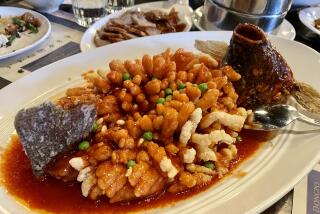Zeal for Eel Lives On in London’s East End : Food: But the slippery fish is seen as a dying delicacy, a victim of the fast-food revolution.
- Share via
LONDON — It comes stewed or jellied and connoisseurs say that served hot it tastes best with mashed potato, beefsteak and kidney pie and green parsley sauce.
Eel, as eaten in London, is a dying delicacy, a victim of changing lifestyles and the spread of American-style fast food.
But on a main thoroughfare in the British capital’s working-class East End, brothers Chris and Fred Cooke are doing their best to keep a long tradition alive.
The Cooke family has filled Londoners’ stomachs with eel for four generations since the present proprietors’ great grandfather Robert chopped up his first fish in 1862.
Their shop in East London’s Dalston district has changed little since it opened in 1910. The same glazed tiles, decorated with scenes of Dutch eel barges, still line the walls.
“My brother and I are both proud of what we do,” said Chris, a cheery 47-year-old whose “Cockney” accent is as much a part of traditional London as Cooke’s eel, pie and mash shop.
“We try to offer the public something they’ve known for generations and try so hard not to change anything,” he said.
The Cookes sell about three-quarters of a ton of eels a week, bought from London’s Billingsgate fish market and stored live in steel trays under fresh running water.
The fish are killed by electric shock in a trough known as a “stunner’ before being gutted, chopped up and cooked. Live eels are also sold from the front of the shop for home cooking.
“It does put people off when they come in and see live eels because in this day and age most people buy things in a packet in a supermarket,” said Chris.
Eel was part of the eastern English diet as far back as the Norman conquest of 1066 and, from the Middle Ages, was a cheap, fresh food for the poor, according to historian C. Anne Wilson.
Although eel is eaten in many countries, the way it is served in Britain--stewed in whole spice when hot or set in an aspic jelly when cold--is particular to London.
The Cooke brothers believe the family firm is probably the oldest in London, one of only about 30 shops left in a city where they say 100 or more existed half a century ago.
“People have got older and families don’t want to carry on,” lamented Chris who, like his 51-year-old brother Fred, has worked in the shop since the age of 7. “It’s very hard work by today’s standards. You’re on your feet for long hours.”
The decline of the eel shop is due in part to an exodus of East Enders to greener suburbs as incomes have swelled in the years since World War II.
Their place has frequently been taken by immigrants to whose palates eel is as alien as it is to those of many Anglo-Saxons.
“I’m fond of eels, except as meals,” wrote the American poet Ogden Nash.
Many of Cooke’s customers are loyalists who return for a taste of the past at what one food guide has called “the Buckingham Palace of eel and pie shops.”
A portion of eel, steak and kidney pie and mashed potato in parsley sauce, known as liquor, costs $5.20, about the same as a large hamburger with French fries.
“Hamburgers and fried chicken have become everyday now so this is more of a treat,” said 22-year-old Mehmet Latif, one of a group of half a dozen local youngsters at one table.
Chris Cooke says he is unconcerned by the two fast-food shops across the street.
“You lose a certain percentage of trade to them but the people who want pie and eel don’t want a hamburger. We’ve no tricks, no gimmicks, no giveaway balloons and paper hats, just good, nutritious food,” he said.
Scientists agree. They cite eels as a rich source of protein and fats that help prevent heart disease. Some say the fact that they contain fatty acids important for the reproductive system may explain why, like oysters, they have a name as an aphrodisiac.
More to Read
Sign up for Essential California
The most important California stories and recommendations in your inbox every morning.
You may occasionally receive promotional content from the Los Angeles Times.













